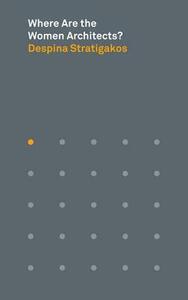Take a photo of a barcode or cover
Dużo danych. Informacje, które nie są powszechnie znane, dowiedziałam się wiele nowych rzeczy. Momentami powtarzają się tak jakby sklejono osobne eseje.
This is a small but mighty little book containing five focused essays (plus intro and conclusion which are powerful essays in themselves) on the state of women in architecture. Highly recommend for anyone in a design profession who is concerned about equity (i.e. should be everyone). It is incredibly well researched and although has an academic tone (Stratigakos teaches at SUNY Buffalo) is very accessible. I’ll be keeping this one on my desk at work for easy reference.
informative
reflective
sad
fast-paced
Excellent. Accurate. Unpacking how I feel about this conversation will take more time than I have now. The rest of my life, potentially.
This book is current, topical and fact-based. Not only informative but engaging and a worth while read.
I had to read this book for class but I was very surprised as to how much I liked it. It was shorter than I thought it would be but it really had a lot of very interesting information.
informative
medium-paced
I really wanted to love this book, and maybe it's because I had such high hopes for it that I felt it was just not a great read and left me frustrated and feeling that this book could have been so much more.
I loved the beginning, with examples of Denise Scott Brown in the shadows of her husband Robert Venturi, but the author completely lost me in the end with examples of how men are keeping women architects down by removing Wikipedia entries about women architects that the author admits some may have not had substantial information. I understand her point, but I really would have preferred to read more about these little-known architects or unknown architects rather than read a rant about how Wikipedia is sexist.
I grabbed this book in hopes of feeling empowered by the amazing things these little-known women architects did and how they overcame being one of few women in a male-dominated field but instead I finished the book frustrated from reading a long rant about how men have kept women down but Wikipedia now has women editors who are adding content about women.
Overall I felt it was just OK. I think I would have enjoyed it more without the last couple chapters, but that last bit just left me feeling disappointed with the book.
I loved the beginning, with examples of Denise Scott Brown in the shadows of her husband Robert Venturi, but the author completely lost me in the end with examples of how men are keeping women architects down by removing Wikipedia entries about women architects that the author admits some may have not had substantial information. I understand her point, but I really would have preferred to read more about these little-known architects or unknown architects rather than read a rant about how Wikipedia is sexist.
I grabbed this book in hopes of feeling empowered by the amazing things these little-known women architects did and how they overcame being one of few women in a male-dominated field but instead I finished the book frustrated from reading a long rant about how men have kept women down but Wikipedia now has women editors who are adding content about women.
Overall I felt it was just OK. I think I would have enjoyed it more without the last couple chapters, but that last bit just left me feeling disappointed with the book.
As someone who works in an architecture firm (as a jack-of-all trades administrative manager, not an architect), and as someone who has always been interested in gender studies and women's roles in careers, this book aligned closely with my professional interests. It's no surprise to anyone within the field of architecture that the field is male dominated - my office is fifty percent female, and yet the senior management is 82% male. (Something that the male leadership is actively trying to change towards more gender balance!) I find myself agreeing with Stratigakos that it can't only be that 50 years ago more men than women graduated from architecture schools, but more that the profession seems to shut women out, not providing equal mentoring or project opportunities.
While I was hoping that Stratigakos would present more ideas for workplace balance, she focuses on a larger picture overview of history of architecture, the possible brokeness of star architect system (no kidding!), architectural prizes, and exposing the field and public to more women architects throughout history.
I'd actually recommend this to those outside of the architectural field who are interested in gender dynamics.
While I was hoping that Stratigakos would present more ideas for workplace balance, she focuses on a larger picture overview of history of architecture, the possible brokeness of star architect system (no kidding!), architectural prizes, and exposing the field and public to more women architects throughout history.
I'd actually recommend this to those outside of the architectural field who are interested in gender dynamics.

